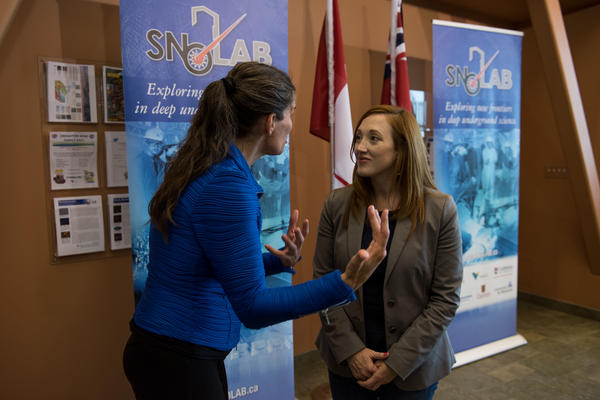Innovative Paint solutions

On the surface, it doesn’t seem that in a physics lab paint would matter all that much. And, literally on the surface, it doesn’t. 2 km underground in SNOLAB, however, it matters a lot. The reason SNOLAB is carved into the rock at the bottom of a mineshaft is to shield incredibly sensitive experiment components from the background radiation that is ubiquitous on Earth’s surface. To maintain this low-background environment, it’s important to ensure nothing in the lab, from the lighting to the table tops, emits significant radiation. This includes, of course, the paint.
SNOLAB’s underground facility is a network of drifts (mine tunnels) and caverns (really big holes where really big experiments are set up), all of which have to be painted. Floor, walls, and ceiling. In addition to being low-emission, the paint underground needed to keep radioactive material in the rock from entering the lab. Specifically, the concern was radioactive radon gas, the stuff that sometimes leeches into basements (when you think about it, SNOLAB is kind of like a giant basement with a unique set of stairs). So, how exactly do you create a barrier between an underground lab and the rock it’s built in/made of/surrounded by?
Enter Barrydowne Paint. A local company that launched in 1981, Barrydowne Paint is now one of the largest distributors of industrial coatings in Canada. Their involvement with SNOLAB actually predates SNOLAB – they began providing underground paint back in the days of the original SNO experiment. What started off as some maintenance work for the SNO facility has grown into one of SNOLAB’s most important industrial partnerships.
When it came time to paint the expanded SNOLAB facility, Barrydowne Paint provided multiple paint swatches which were taken underground and tested for suitability (the ideal candidate would have no off-gassing, and also completely seal the walls). The winner turned out to be a new product on the market, a 100% solids epoxy created by a Canadian company.
Unusually for industrial jobs, the actual painting was done by SNOLAB staff, rather than professional painters. Barrydowne Paint owner Kelly Scott recalls going underground to train staff how to apply the paint, and that the whole process required some creativity to address the challenges this project presented. Underground facilities are notoriously challenging because moisture in the rock can cause paint to peel and flake, and like any project, will eventually need to be re-painted.
Looking forward, Scott is excited about the opportunities this partnership with SNOLAB represents. When asked what is next, she responded, “we will be looking for further solutions around challenges with moisture, and possibly using this environment to test products in the future.” SNOLAB is also looking forward to working with Barrydowne Paint in the future. It is committed industrial partners like this that enable the world-class research SNOLAB produces, and it is always a pleasure to work with organizations who are part of the Greater Sudbury Community.
Jenna Saffin
Communiations Coordinator